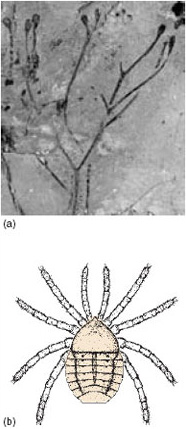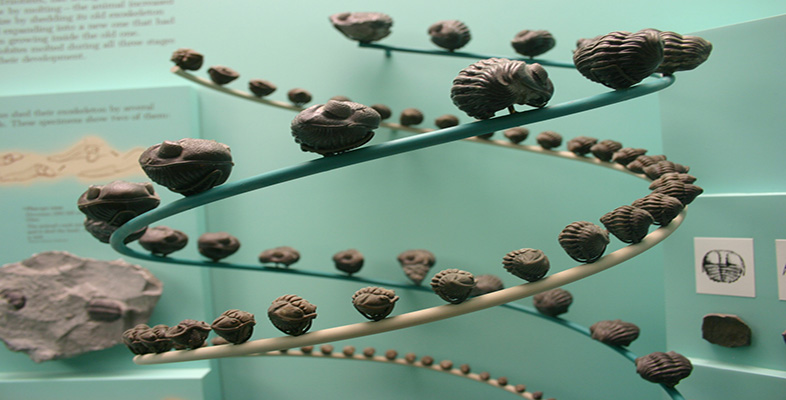3 The Silurian Period and the invasion of the land
Before going any further, click on 'View document' below and read pages 72-75 from Douglas Palmer's Atlas of the Prehistoric World.
View document [Tip: hold Ctrl and click a link to open it in a new tab. (Hide tip)]
SAQ 7
What global event had reduced global sea level at the end of Ordovician times, drastically affecting shallow marine organisms, and leaving the diversity of early Silurian life severely curtailed?
Answer
The global climate descended into an ice age, locking up ocean water in the polar ice caps, exposing much of the continental shelves above sea level, eliminating many shallow marine habitats and driving many species to extinction (Atlas, p. 69). (Sea level probably fell by about 100 m, not 330 m as stated in the Atlas.)
Recent research shows that minor glaciations continued into the early Silurian, but after a while the oceans became warmer again and sea levels rose. It took several million years for marine life to recover. At first, stromatolites were relatively common, apparently because the organisms that normally suppressed them had suffered severely, but by mid Silurian times, vast coral reefs were established in tropical waters, promoting a rich diversity of organisms. The growth of corals with their tough, mineralised skeletons turns flat sea beds into complex 3-D topographies, baffling ocean currents, and providing sheltered surfaces and new ecological niches. We will soon study some of the organisms that thrived in such environments.
Meanwhile, the animals and plants that were invading the land faced all sorts of environmental challenges to which they had to adapt. For example, if a marine plant cell is directly surrounded by fresh water, the water tends to flow into it by the process of osmosis, causing it to burst. Alternatively, if the cell is directly surrounded by air, it loses all its water, just as seaweeds become hard and crisp when stranded above high tide and exposed to the wind and the sun. So, to survive in air, plants had to acquire an effective outer coat to keep the right amount of water in. They also had to evolve small, controllable pores to enable gases to be exchanged through this coat. Expressed this way, it is all too easy to give the impression, quite wrongly, that such innovations could be achieved intentionally, almost as if by some directed effort. On the contrary, as in all evolutionary explanations, natural selection would have favoured those organisms that were, by chance, better adapted to these new environmental challenges.
Without the buoyancy provided by immersion in water, adaptations in both plants and animals were needed to support a body on land against the pull of gravity. The relatively high density of water provides much greater support for the bodies of marine organisms than does less dense air - hence the expression 'like a fish out of water'. To grow up off the land surface, plants had to develop groups of special plumbing cells to conduct water, nutrients and the products of photosynthesis around their bodies. Only about 4 cm tall, Cooksonia (see Figure 3a and illustration, Atlas, p. 75) lacked leaves, and sent short, forking shoots upward to capture sunlight and release spores (reproductive cells) into the wind. These first true vascular land plants with specialised cells for carrying fluids around an upright plant were still dependent on water for reproduction, and lived in swamps and on riverbanks and floodplains. The earliest movement onto land, for both plants and animals, seems to have been through the medium of fresh, as opposed to saline, water.
Air, being a gas, has a low capacity to store heat compared with seawater and, to survive, life on land must be able to withstand relatively large temperature fluctuations as well as higher amounts of ultraviolet radiation from the Sun. Exchange of gametes during reproduction is also much easier in water where male gametes can swim to fertilise the female ones. The animals that, by chance, were best adapted to life on land were the arthropods. They were very strong for their size, and already had an almost waterproof outer skeleton that was resistant to damage by ultraviolet light. Numerous paired and jointed limbs with internal muscles helped overcome gravity and allow movement over uneven terrestrial surfaces. However, the arthropods could not have invaded the land if there had not already been some supply of food there.
SAQ 8
According to the Atlas (p. 74), what are the first arthropods believed to have eaten?
Answer
The first arthropods were probably eating the decaying remains of plants such as Cooksonia.
Once the greening of the land had begun, small millipedes and wingless insects were apparently tempted onto it to eat the rotting plant debris, and they and their remains were eaten in turn by predatory or scavenging carnivorous arthropods such as centipedes, scorpions and small spider-like creatures (Figure 3b).

